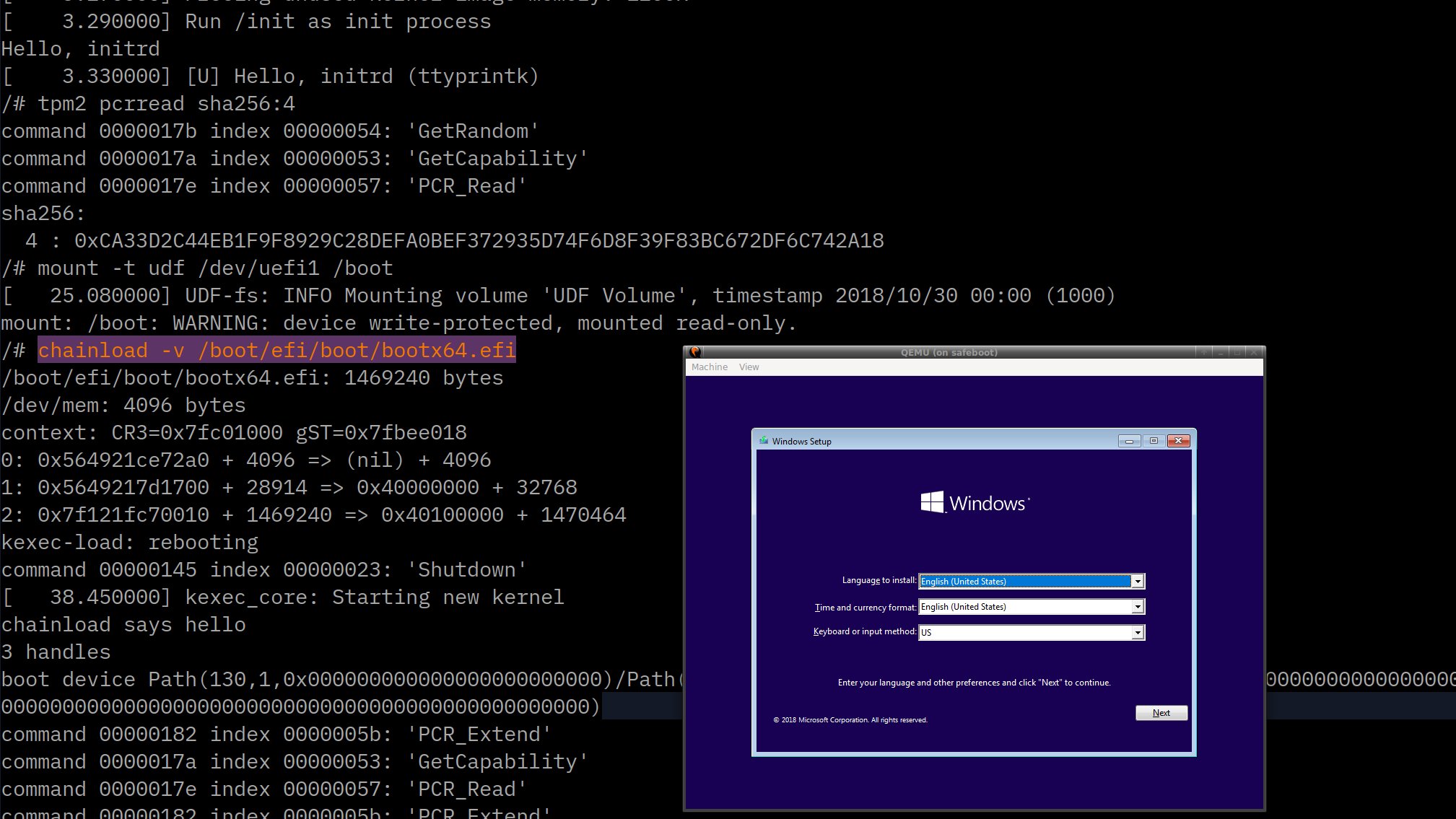This tree allows Linux to run as an EFI boot loader application and to hand control back to the UEFI firmware so that it can chainload into another EFI executable, such as the Windows boot loader. It doesn't touch any devices or UEFI memory, so the firmware state is retained upon resuming the UEFI context.
This module provides Linux device driver wrappers for several of the
UEFI vendor firmwre provided interfaces. Normally this is not possible
since Linux calls gBS->ExitBootServices(), which tears down most
of the UEFI device drivers, and because Linux does not have a memory
mapping for the UEFI linear memory.
This module depends on a specially modified loader for the
kernel that makes the first call to ExitBootServices() into a NOP,
and then returns succes. The loader also allocates memory for the
kernel at 1 GB and passes this to the kernel with the memmap=exactmap
command line option option to ensure that the Linux kernel doesn't
accidentally modify any of the UEFI data structures.
The technique of writing directly to CR3 is a total expedient hack and definitely not a production ready sort of way to restore the memory map.
This submodule provides an interface to the vendor firmware's registered
EFI_BLOCK_IO_PROTOCOL handlers, which allows Linux to use them
as if they were normal block devices. UEFI tends to create a block
device for the entire disk and then separate ones for each partitions.
You can also have Linux detect the partitions by using losetup on
the whole disk device:
losetup -f -P /dev/uefi0
mount /dev/loop0p2 /boot
Or something like this, although your device numbers might be different:
mount -o ro /dev/uefi6 /boot
You can retrieve the UEFI DevicePath or handle from
cat /sys/devices/virtual/block/uefi6/uefi_devicepath
cat /sys/devices/virtual/block/uefi6/uefi_handle
Todo:
- Benchmark the performance
- Test with the ramdisk module
- Support CDROM devices with their big block sizes
The Linux boot loader can pass data to the next stage via a UEFI
ramdisk, which can be created by echo'ing the disk image file name into
/sys/firmware/efi/ramdisk.
New UEFI modules can be loaded by echo'ing the file name into
/sys/firmware/efi/loader. This should measure them into
the TPM and eventlog. It can also be used to chain load
the next stage, although this won't turn off the Linux interrupts
and can cause problems. Use the chainload tool instead.
This submodule create an ethernet interface for each of the
vendor firmware's registered EFI_SIMPLE_NETWORK_PROTOCOL devices.
The Linux skb transmit functions put packets directly on the wire,
and there is a periodic timer that polls at 100 Hz for up to ten packets.
It's not going to be a fast interface, but it will hopefully be enough
to perform attestations or other boot time activities.
Todo:
- Make polling timer a parameter
- Interface with the UEFI event system?
Because ACPI and PCI are disabled, the TPM is not currently visible
to Linux via the normal channels. Instead this submodule will
query the EFI_TCG2_PROTOCOL objects and create TPM character
devices for each of them. While the UEFI object has methods for
high-level things like "Extend a PCR and create an event log entry",
this module uses the SubmitCommand method to send the raw commands
that the Linux driver generates. It buffers the response and returns
it immediately; there is no overlapping of commands or multi-threading
allowed.
Todo:
- Figure out how to expose the TPM.
- Figure out how to export the TPM event log
- Change the event log to be "live" rather than a copy
The chainload program has a small purgatory to resume the
UEFI context that the loader.efi has stored at 0x100 in physical
memory. It also assumes that the next image to be run is in
virtual memory at 0x40100000 and calls gBS->LoadImage() and
then gBS->StartImage() on it to transfer control to the
new kernel.
Typical usage is:
mount -o ro /dev/uefi6 /boot
chainload -v --boot-device uefi6 /boot/EFI/Boot/bootx64.efi
- Device path for the loaded image is passed in
The Makefile will download and patch a 5.4.117 kernel with the
to add the uefidev kernel module as an in-tree build option.
It will then apply a minimal config that has no PCI drivers and
uses the EFI framebuffer for video.
make -j$(nproc)
This will produce after a while bootx64.efi that contains the
kernel and a minimal initrd, unified with the loader.efi program
using the same objcopy technique as the systemd EFI stub.
You can sign it with sbsigntool for SecureBoot systems or
boot it without signing on qemu.
Creating the local machine state (not including the TPM):
qemu-img create win10.hda 12G
Launching the emulator is messy due to the need to pass in the separate
UEFI nvram (the one in config/OVMF_VARS.fd has been modified so that
the UEFI boot order starts with PXE; otherwise the virtual machine will
always boot via the hard disk since OVMF ignores the -boot n option
to request a network boot).
You can run make qemu or:
qemu-system-x86_64 \
-M q35,accel=kvm \
-m 2G \
-drive if=pflash,format=raw,readonly,file=/usr/share/OVMF/OVMF_CODE.fd \
-drive if=pflash,format=raw,file=config/OVMF_VARS.fd \
-netdev user,id=eth0,tftp=.,bootfile=build/bootx64.efi \
-device e1000,netdev=eth0 \
-serial stdio \
-cdrom win10.iso \
-hda win10.img
To emulate a TPM 2.0, install or build the swtpm package and
run with make TPM=1 qemu. The TPM's EK will be in build/tpm-state/ek.pem
for attestation verification.
Tested with:
For more convenient debugging, you can turn off the graphical QEMU window:
make NOGRAPHIC=1 qemu
- Wrap kernel building in the
Makefile -
initrd.cpiobuilding - Unified image building with the loader
- LinuxKit or buildroot integration?
memmap=exactmap,32K@0G,512M@1G noefi acpi=off
- Make the loader built this addition to the command line
- Allocate the SMP trampoline correclty in UEFI
